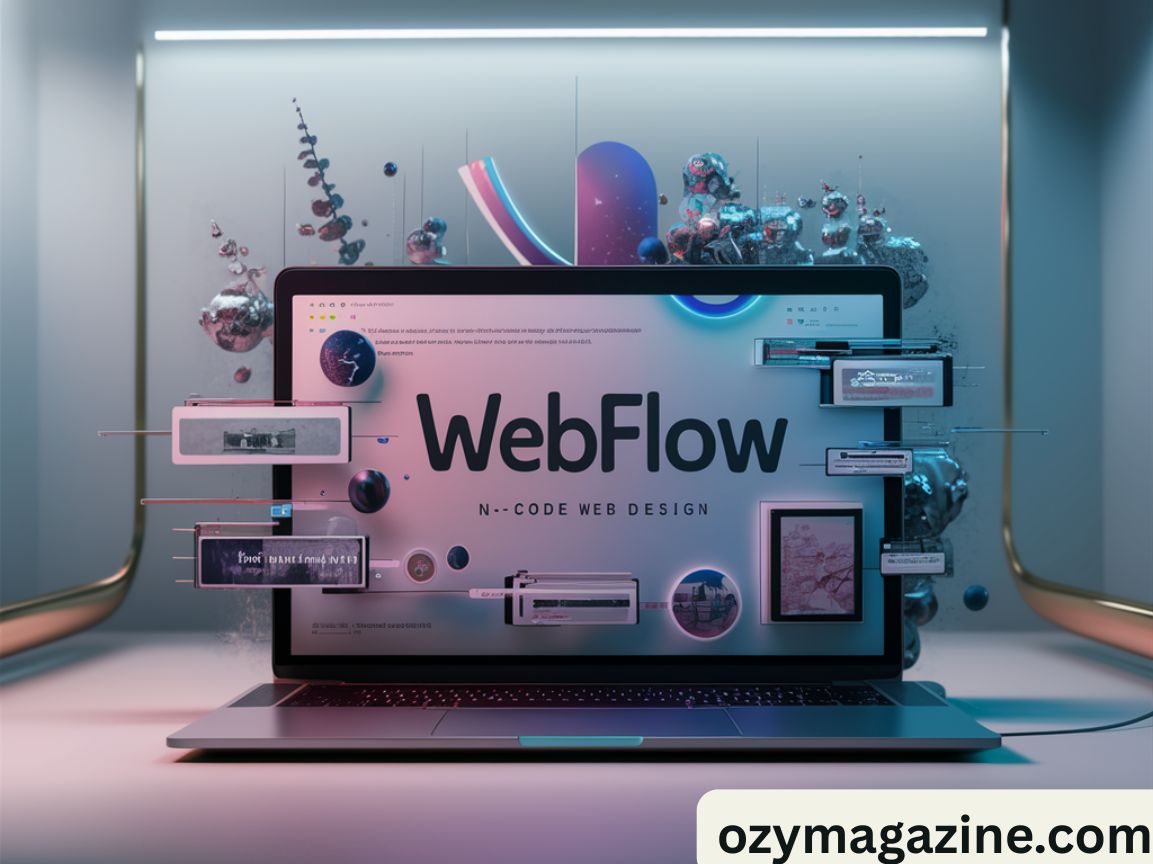Webflow Software is a no-code platform for building websites. It allows users to design, manage, and publish sites without coding. It combines design tools, CMS, hosting, and e-commerce in one place.
Building websites has always been slow and complex. Webflow Software changes this with speed and simplicity. It helps U.S. businesses launch websites faster than ever.
With Webflow Software, users control design and content together. It supports animations, automation, and third-party integrations. This makes it a complete web design solution for modern needs.
What Kind of Software is Webflow?
Webflow is a cloud-based, no-code software that allows users to visually design websites while still generating clean, production-ready code. Unlike traditional builders such as WordPress or Wix, which often depend on themes, plugins, or rigid templates, Webflow offers the flexibility of front-end development but without the steep learning curve of coding.
In essence, Webflow can be described as a hybrid between a design tool and a development environment. Designers who are comfortable with tools like Adobe XD or Figma feel right at home, but instead of creating static mockups, they are creating fully functional websites. This unique approach has made Webflow particularly attractive in the U.S., where businesses seek faster time-to-market, lower costs, and modern design capabilities that reflect current digital trends.
The Core Components of Webflow Software

The Webflow Designer (The Visual Builder)
At the heart of Webflow is the Designer, often referred to as the visual builder. The Designer allows users to craft pixel-perfect websites without writing a single line of code. What makes it stand out is that while it is no-code, it does not sacrifice flexibility. Instead of dragging pre-styled blocks, users have access to the underlying structure of HTML and CSS in a visual way. This means you can control typography, spacing, animations, and layouts with the same precision a front-end developer would have, but without having to code manually.
Case studies from U.S.-based agencies highlight how Webflow Designer speeds up project delivery by weeks compared to traditional development workflows. For example, a creative agency in New York reported cutting down design-to-launch time by nearly 50% by using Webflow Designer instead of outsourcing development.
The Webflow CMS (Content Management System)
The Webflow CMS is not just a content repository but a flexible way to structure dynamic content. Unlike traditional CMS platforms that lock you into fixed templates, Webflow CMS lets you create custom collections that adapt to any type of project. Whether it’s a blog, a real estate listing, or a product directory, content fields can be structured according to your business needs.
Many U.S. companies use Webflow CMS to scale marketing campaigns because it enables content editors and marketers to update text, images, and links without touching the design. This separation of design and content makes it easier to manage large projects while keeping the design consistent.
The Webflow Interactions Engine
Modern websites demand more than static pages. Users expect interactive experiences that engage them and guide them through content. The Webflow Interactions Engine is a tool built into the platform that allows users to design complex animations, hover effects, scroll-triggered interactions, and transitions—all without code.
For instance, U.S.-based SaaS companies often use interactions to demonstrate product features visually. A landing page that animates key software workflows as the user scrolls can drastically improve engagement rates. Instead of hiring JavaScript developers, marketers and designers can achieve these effects directly in Webflow.
The Webflow E-commerce Platform
E-commerce has become a cornerstone of business in the U.S., with thousands of small and medium retailers moving online. Webflow’s E-commerce Platform is designed to give business owners full control over their store’s design, checkout flow, and product presentation. Unlike Shopify or WooCommerce, which often limit customization unless you dive into code, Webflow e-commerce allows businesses to build completely custom shopping experiences.
In a comparison study between Webflow and Shopify, Webflow was shown to offer stronger design flexibility, while Shopify provided more extensive third-party app support. For smaller U.S. retailers who want to stand out visually and control the branding of their stores, Webflow often becomes the preferred choice.
Webflow Hosting & Publishing Infrastructure
One of the most underrated but powerful components of Webflow is its hosting and publishing infrastructure. Built on top of Amazon Web Services (AWS) and Fastly, Webflow hosting ensures high speed, scalability, and global content delivery. Websites published through Webflow automatically benefit from features such as SSL certificates, content delivery networks (CDNs), and zero-downtime publishing.
This infrastructure is particularly valuable for U.S. businesses that rely on performance. A fast-loading website not only improves user experience but also boosts SEO rankings. According to Google research, websites that load within three seconds have 53% lower bounce rates, making Webflow hosting a significant advantage.
Webflow Logic (No-Code Automation)
A newer addition to Webflow is Logic, which allows users to build automations inside their websites. Think of Logic as a way to replace repetitive tasks with no-code workflows. Businesses in the USA use Logic to automate things like lead form processing, content filtering, or conditional display of information based on user behavior.
This means a small U.S. startup can automate customer sign-ups directly from their Webflow website into their CRM without paying for complex middleware. By embedding no-code automation directly into the platform, Webflow reduces dependency on third-party services and lowers operational costs.
Integrations & Extensibility
No software is complete without the ability to connect to other tools. Webflow integrates with a wide range of platforms that are heavily used in the U.S. digital ecosystem, such as Zapier, HubSpot, Google Analytics, and Stripe. For advanced users, Webflow also provides APIs to extend functionality.
This extensibility makes Webflow an adaptable hub for digital projects. A U.S. agency might connect Webflow with HubSpot for lead management, Stripe for payments, and Zapier for automating workflows—all while keeping Webflow as the central design and publishing platform.
Webflow’s Unique Approach to Software Development
Unlike many no-code tools that simply hide the code, Webflow takes a visual-first approach while still generating clean, semantic HTML, CSS, and JavaScript in the background. This means websites built on Webflow are not just visually appealing but also technically sound for SEO and scalability.
Webflow also invests heavily in community-driven growth. Webflow University provides free educational content, making it easier for U.S. designers, marketers, and developers to adopt the platform. Annual Webflow events in the U.S. have further strengthened the ecosystem, turning Webflow from just a tool into a movement.
What Types of Projects Does Webflow Software Excel At?

Webflow software is versatile and can be applied to a wide range of projects in the U.S. market. Local service providers use it to build professional websites quickly, while startups rely on it for marketing sites that need to look polished and modern. Creative professionals, such as photographers and agencies, often use Webflow for portfolio websites because of its flexibility in showcasing visual content.
E-commerce businesses in the U.S. leverage Webflow to design customized storefronts that stand out in a crowded digital market. Larger organizations and enterprises use Webflow CMS to manage complex, dynamic websites with thousands of content entries. From one-page landing pages to full-scale enterprise platforms, Webflow has proven itself across industries.
Read Also : Your Ultimate Guide to blakeyeo.com Celebrity News
The Advantages of Webflow as a Software Solution
The primary advantage of Webflow is that it is an all-in-one platform. Users do not need to worry about installing plugins, managing security updates, or dealing with broken code. Everything from design to hosting is handled within Webflow.
Another significant advantage is performance. Because Webflow websites are optimized at the code level and served on high-speed infrastructure, they consistently outperform many traditional CMS platforms in loading speed and stability. This is crucial in the U.S. digital market, where competition for attention is fierce.
From a financial perspective, Webflow reduces costs by minimizing the need for developers for smaller projects. For U.S. businesses, this means they can allocate budgets to growth and marketing instead of lengthy development cycles. In addition, the platform’s focus on security and SEO ensures that businesses have a future-proof digital presence.
Why Webflow Software is Different from Other Website Builders
Most website builders focus on simplicity but sacrifice flexibility. Webflow gives you both—an easy no-code interface with the power of custom development. This makes it a perfect balance for U.S. businesses that want modern designs without coding.
Unlike tools that rely on themes or plugins, Webflow allows full creative control. You can design layouts from scratch while still keeping the site clean, responsive, and SEO-friendly. That’s why designers and agencies in the U.S. love it.
How Webflow Software Saves Time and Money
Building a site traditionally meant hiring developers, waiting weeks, and spending thousands. Webflow software changes this by letting teams go from idea to launch much faster. This time-saving directly reduces costs for U.S. startups and agencies.
Instead of juggling multiple tools for design, CMS, and hosting, Webflow offers everything in one place. Businesses save money by eliminating plugin fees and developer hours, making it a budget-friendly option for many.
The Role of Webflow in Modern U.S. Marketing

Digital marketing in the U.S. moves fast, and brands need websites that can adapt. With Webflow, marketing teams can update content instantly without touching code. This helps campaigns stay relevant and timely.
From interactive landing pages to animated product showcases, Webflow makes marketing websites stand out. U.S. companies use it to create unique online experiences that attract and retain customers.
Why U.S. Startups Prefer Webflow Software
Startups in the U.S. need to move quickly to stay ahead. Webflow lets them launch professional websites in days instead of months. This speed gives them an edge in fast-paced industries like tech and e-commerce.
In addition, Webflow offers scalability. A startup can begin with a simple website and expand into e-commerce or enterprise-level solutions without switching platforms. This flexibility is key to long-term growth.
The Future of No-Code with Webflow Software
The no-code movement is growing fast in the U.S., and Webflow is at the center of it. By giving people design power without coding, it democratizes web development. Anyone with creativity can now build a professional website.
As Webflow adds new tools like automation and integrations, its role in the digital ecosystem keeps expanding. It’s not just software; it’s shaping the future of how Americans build and manage their online presence.
Conclusion
In today’s competitive digital landscape, Webflow Software has emerged as the leading all-in-one no-code web design solution. Its combination of a powerful visual designer, flexible CMS, built-in hosting, automation, and e-commerce makes it a compelling choice for U.S. businesses of all sizes. By bridging the gap between design and development, Webflow empowers creators to build professional websites faster, smarter, and without compromise.
For agencies, startups, and enterprises in the USA, Webflow is more than just a website builder. It is a complete digital ecosystem designed to keep pace with the demands of modern web design. The future of no-code development is here, and Webflow is at the forefront of this movement.










